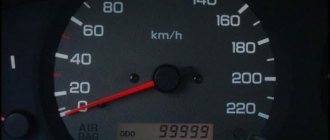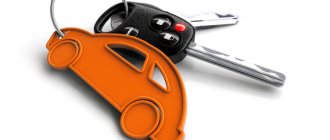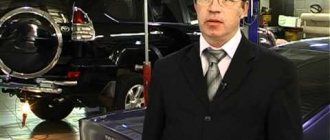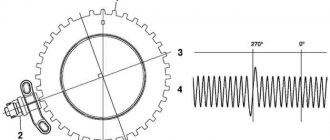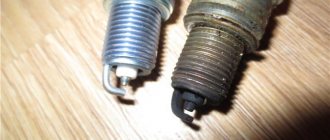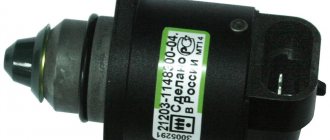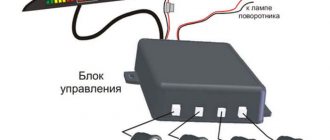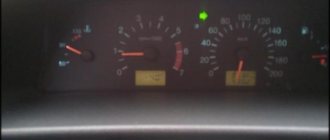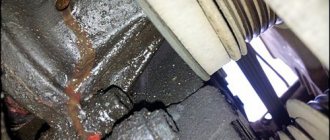How to determine that the parking sensors have stopped working?
Determining that the parking sensors have stopped working is quite simple. If your car has a parking sensor installed from the factory, there is an indicator on the dashboard that will indicate that it is broken. But if you installed an acoustic parking system yourself, then in order to identify a breakdown you should observe its operation. It will either be constantly silent until you crash into something, or it will constantly give signals about non-existent obstacles. But recognizing what exactly has gone wrong is a little more difficult.
Wiring
If the parking sensors stop working, the reasons are often related to the wiring. Wires may be broken or crushed. Poor contact with the sensor, oxidation, short circuit is possible. Sometimes the cable insulation is torn off.
Another likely reason is lack of nutrition. Perhaps the problem is a break in the power wire supplied to the control unit. It is also worth checking the integrity of the corresponding fuses and the grounding of the device - without a good “ground” the electronics will not work normally.
The parking sensor does not beep when there is an obstacle. What is the reason?
First of all, you should find out which sensor “does not see” the obstacle. This is very simple to do: you need to cover each sensor with your hand in turn, and an assistant should monitor the parking sensor indicator in the cabin. If all sensors are normal, you can try increasing the sensitivity of the parking sensors
.Carefully inspect all sensors: perhaps the reason for their “silence” is damage
one of them.
It happens that a pebble hits right in the center of the sensor and breaks the parking sensor mirror. If a damaged sensor is found, you can contact the service to replace it or do it yourself. In this case, it is not necessary to install a “original” sensor, you can choose one that is suitable in size and characteristics - if it does not match the color, you can paint it without any problems. Please note that the parking sensors may also not work or, conversely, work for no reason, due to faults in ECU
, however, in this case it is better not to repair it yourself. Illiterate interference with the operation of the electronic control unit may result in new, even more expensive repairs.
If recently parking sensors were considered a luxury, then in a big city where finding a parking space is quite difficult, it has become a necessity. If the parking sensors do not work, then for those who are used to using them, this is a real problem. The article discusses the main malfunctions of the device, ways to check the sensor, and provides instructions on how to disable, remove and replace the device on your car.
Detailed installation of parking sensors with your own hands
Today I have prepared step-by-step instructions on how to install parking sensors. I will install a device from ParkCity using a Hyundai Accent as an example. I install ParkCity SMART parking sensors with 4 sensors, also known as rear parking radar. The ParkCity SMART parking sensor package includes:— user manual in Russian;— display;— set of wires;— central block of parking sensors;— cutter for drilling a hole in the bumper— parking sensors, gray, similar to the color of the car;— zip ties;— tape for marking.
I consider the advantages of ParkCity parking sensors to be a wide range of colors and long wires from the sensors to the unit, so this kit can even be installed on the front of the car.
The installation of parking sensors begins with disassembling the trunk of the car. I removed the decorative protective plastic and side trim. The reverse gear in the Hyundai Accent is located on the right lamp, so we will pull all the wires to it. We will run the wire from the display and parking sensors into the trunk, where we will install the central parking sensor unit. Let's connect all this to the lantern. I also looked under the bottom of the bumper to see how far away the bumper amplifier was.
Now you need to mark where the parking sensors will be installed. For these purposes, I use a laser level, but if you want to install parking sensors yourself and do not have this tool, then you can safely do without it.
We set the laser level so that it catches the horizon and the middle of the car. We mark from the center. I try to place the two central parking sensors a little further away, in case the car owner wants to install a tow bar. Be sure to check whether the car is level. If not, then use a jack to lift the desired side. Having marked the points, mark them with a pencil.
We poke holes with an awl and drill holes for the sensors in the bumper with a milling cutter. I don’t drill at once because the cutter gets clogged. If you don't clean it, you can make a larger hole.
We trim the finished holes with a knife to remove chamfers and burrs.
The next stage is laying wires for parking sensors. Please pay attention to the numbering so as not to confuse the sides. To route the parking radar wiring under the bumper, I use a metal broach. I stretch it from hole to hole, wrap the necessary wire and stretch it.
I leave a small tail to make it easier to change a non-working sensor in the future.
When all the wires are pushed under the bumper, we lead them into the trunk using a broach. We carefully place the wires in the trunk and tighten them.
We decide on a place for the parking sensors unit.
We secure the remaining tangle of wires and, if possible, hide them somewhere in the trunk. I placed them in the trunk niche.
Now let's go to the car interior. We will attach the parking sensor monitor to the rear view mirror, on top. To increase the contact area, I glued the monitor a little with double-sided tape.
Having glued the monitor, we fix the wire on the leg of the mirror. Next, under the ceiling trim, we lead to the pillar, and along the side surface to the rear of the car. I had to additionally remove the side pillar and visor.
Having pulled all the wires into the trunk, we connect them to the central parking sensor unit.
All that's left to do is connect the power wires. Black wire, mass - “minus”. "Plus" is green. We fix the wires and insulate them.
We will install parking sensors. I bend the metal antennae of the sensor clamp a little so that in the future it will not be so difficult to remove it. To do this, I take them off and bend them a little inward. I determine how much to bend empirically. It is necessary that the sensor can be reached without falling out.
Next, we connect the sensor to the wire laid in the bumper. We wind the resulting wire in a loop so that it does not fall out from the bottom of the bumper.
We insert the parking sensors wide down, with the “UP” mark up. It is not necessary to refer to the numbering of the sensors during installation, since they are identical.
Let's check how the parking sensors work. After making sure that everything is connected correctly, we secure the central unit. I attach it with double-sided tape and tighten it by the ear for a secure fit. Putting the car trunk back together.
This concludes the installation of parking sensors with your own hands. Be sure to leave questions and comments under the post.
Auto electrician Sergei Zaitsev worked for you!
Post by user stozaycev from the DIY community on DRIVE2
How to avoid parking sensor malfunctions?
First of all, you need to follow basic safety measures. Sensors, metallized tape, wires, contacts must be inspected regularly; if dirt appears on the sensors and tape, it must be removed, as well as moisture. No moisture or dirt should accumulate under the metallized tape. Therefore, you need to periodically remove it and clean the inside of the bumper.
Dirt can also collect in the control unit; it is worth opening it occasionally and cleaning it from the dirt and dust accumulated inside. Please note that dirt, dust and water are excellent conductors of electricity, which means they can cause a malfunction.
It is necessary to strictly follow the recommendations and requirements set out in the parking sensor operating instructions. It is very important to correctly install and select the device, as well as fine-tune it. You can find out more detailed information about choosing parking sensors in the following detailed article. Following the instructions, correct installation, and fine-tuning of the parking sensors is the key to its long, trouble-free service.
How to put the sensor back in place
Therefore, you need to remove the bumper, return the sensor to its original position and secure it. If the fasteners come off, secure the latches. If they are broken, replace them with new ones. You can also use double-sided tape, having previously degreased the gluing area. Make sure the alarm is firmly seated in its groove. Try pressing lightly on the back side. It should not play, press in or rotate. If the device is not secured securely, the problem may soon return.
Repair wisdom
Performing diagnostics dictates the choice of an effective method for correcting defects. If the parking sensors constantly beep, we are talking about contamination of the sensors. It is necessary to inspect them, wipe the sensors with a dry soft cloth. He especially likes to make such sounds on a frosty day or after washing. This happens because water gets into the sensor and freezes in the cold. Drying the device eliminates the need for repairs. To do this, you can put your favorite “swallow” in a heated room.
Setting matters in this matter: if the sensors are configured incorrectly, you have to deal with the annoyingly stable signal of the device. Whether the beeping occurs or not, the likelihood of replacing the sensors is close. It is better to do this in the service. To avoid reaction to growing grass, you will need to adjust the sensitivity of the devices. A service book and a pair of screwdrivers are eternal companions for self-repair, but it’s better not to do this: the process is labor-intensive and not justified. Service station specialists with professional knowledge, a competent approach, and knowledge of the technical condition will figure out what’s wrong much faster and find the most effective tactics for troubleshooting.
Frosty weather
One of the common situations is that the parking sensors constantly beep in the frosty and snowy seasons. This occurs due to the accumulation of ice and snow on the car bumpers. The simplest thing is to clean the sensors from ice and foreign contaminants.
If it is not possible to restore functionality using a simple method, the reason may be the freezing of the liquid that forms on the surface of the parking sensors. Place the machine in a dry, heated area to thoroughly dry the electronics.
Diagnostics and repair options
The system must respond to emerging obstacles. If this does not happen, then the first thing to do is to clean the sensors or tape from dirt and moisture. They very often cause malfunctions of the device. You also need to clean the places where they are located. That is, the inside of the bumper under the tape and the sockets in which the sensors are installed. It doesn’t help - we inspect the transceiver devices.
If there is no damage on the metallized tape, then the cause of the malfunction of the parking sensor tape is in other parts of the device.
To determine whether the sensor is working properly, you need to touch it with your finger. A working sensor vibrates slightly. When touched, a slight cracking sound is heard. The check is carried out with the vehicle engine running.
When engaging reverse
If the parking sensors constantly beep when you engage reverse gear, even if there are no obstacles around, most likely you have set the sensitivity threshold in the radar settings too high. As a result, the system incorrectly calculates the distance to objects, sincerely believing that a fence 10 m from the car is about to merge with it in a “happy kiss”. By the way, the faster you drive, the more active the parking sensors are.
Go to the radar settings and reduce the sensitivity.
Which model to choose
The operating principle of parking sensors is based on the reflection of an ultrasonic signal from an obstacle and its reception by the sensor. Their number determines the size of the controlled area. The more sensors, the fewer blind spots behind the car. Due to the fact that the power of the emitters is low, the parking sensors can detect an obstacle at a distance of 2-2.5 m. The change in the distance to an object for different models is fixed from 1 to 10 cm, and the minimum operating distance of the radar is 10-30 cm. The characteristics and quality of parking sensors depend on the manufacturer.
Special radars
Experience shows that the presence of a large number of sensors will ensure high-precision products. Branded models are in trend, so it is recommended to pay attention to the name of the manufacturer and get acquainted with the experiences of other traffic participants on forums. There are special models on the market - parking radars with 8 sensors, expanding visibility by 100%. Some foreign cars already have such a mechanism, so you don’t need to buy it separately. These include options Park Master8FJ-27, Phantom DP 8Z, etc. They provide an LCD display, sound indication in Russian, interesting lighting, and a shape that gives a special charm to the car. The models allow you to quickly park vehicles without any incidents. Overhead models are available for sale and can be installed without assistance.
How to turn off the parking sensor sound
If your car's parking sensor fails, a notification will appear on the dashboard indicating that it is close to an object. This is a reaction to the outer wall of the bumper, which is recognized as a normal obstacle. The signal will remain until you repair the parking sensors or turn it off. To turn off the sound, disconnect the problematic sensor from the parking sensors unit. The signal can also be removed via firmware. For example, the Volkswagen Touareg NF and Touareg FL have a temporary mute function, which can be found in the OPS menu.
Best driving instructors:
Automotive instructor Svetlana Automatic transmission: Hyundai Accent Trains in Northern Administrative Okrug, North-Western Administrative Okrug, Khimki REVIEWS
Driving instructor Elena Automatic transmission: Chevrolet Lacetti Manual transmission: Chevrolet Lanos Trains in the Southern Administrative District, South-East Administrative District, Vidnoye, Domodedovo REVIEWS
Driving instructor Marina Automatic transmission: Kia Cerato Manual transmission: Chevrolet Lanos Trains in Northern Administrative Okrug, Dolgoprudny REVIEWS
Driving instructor Elena Automatic transmission: Kia Cerato Manual transmission: Chevrolet Lanos Trains in Northern Administrative Okrug, North-Western Administrative Okrug, Khimki REVIEWS
Driving instructor Natalya Automatic transmission: Kia Spectra Teaches in the Eastern Administrative District, Balashikha, Reutov REVIEWS
Driving instructor Oleg Automatic transmission: Chevrolet Lacetti Manual transmission: Chevrolet Lanos Trains in Northern Administrative Okrug, Dolgoprudny REVIEWS
Driving instructor Yana Automatic transmission: Kia Spectra Teaches in the Northern Administrative Okrug, Dolgoprudny REVIEWS
Driving instructor Yulia Automatic transmission: Chevrolet Lacetti Manual transmission: Chevrolet Lanos Trains in the Eastern Administrative District, South-East Administrative District, Lyubertsy, Reutov, Zheleznodorozhny REVIEWS
Automotive instructor Svetlana Automatic transmission: Chevrolet Lacetti Trains at Northwestern Administrative Okrug REVIEWS
Driving instructor Tatyana Manual transmission: Chevrolet Lanos Automatic transmission: Kia Spectr Teaches in Krasnogorsk REVIEWS
Driving instructor Peter Manual: Daewoo Nexia Trains at Northwestern Administrative Okrug REVIEWS
Automotive instructor Oksana Automatic transmission: Hyundai Accent Teaches in North-Eastern Administrative District, Mytishchi, Korolev, Pushkin REVIEWS
Driving instructor Dmitry Automatic transmission: Volkswagen Golf Manual transmission: Chevrolet Lanos Trains in North-East Administrative District, Northern Administrative District, North-Western Administrative District, Dolgoprudny REVIEWS
Driving instructor Oksana Automatic transmission: Kia Spectra Manual transmission: Chevrolet Lanos Trains in the Southern Administrative District, South-Western Administrative District, Vidnoye, Podolsk REVIEWS
Automotive instructor Dmitry Manual transmission: Lada Granta Teaches in the South-East Administrative District, Lyubertsy REVIEWS
Functional highlights
The system is supplied by the manufacturer with a camera, transmitting and receiving units. The video image enters the transmitter unit, which sends data to the receiver. The picture is displayed on the monitor, helping the driver to park close to other cars, eliminating “blind spots”, without touching other people’s vehicles. Sealed rear view cameras and infrared illumination have a beneficial effect on parking at night. The best option is a harmonious union of the camera with the electronic system. This is the ability to recognize obstacles when sensors cannot cope with this task.
Sensors
If parking sensors do not work in a car, the reasons are most often associated with incorrect operation of the sensors.
- Pollution, accumulation of ice, snow. These are very common causes of parking sensor failure. Ultrasonic sonar includes both a transmitter and a receiver. Therefore, the adhesion of ice or dirt can lead to both a decrease in sensitivity (the system will not see the obstacle at all or incorrectly determine the distance to it), and to false alarms due to the reflection of the signal from interference on the outer surface of the device. Contamination also leads to malfunctions if metallized tape is used instead of sonars.
- Moisture ingress. Typically, sensors are manufactured in waterproof housings. However, it is still possible for liquid to get inside, especially under strong water pressure at the sink. Moisture can cause both short-term problems and complete failure of the device. If the parking sensor constantly beeps, one of the possible reasons is moisture ingress.
- Mechanical damage, distortion. The sonar may be damaged by impact. It is also possible that there is a skew, due to which the signal will be emitted in the wrong direction, and even the device falling inside the bumper.
- Poor fastening. Poor installation may result in loss of contact with the connecting wires. The device body sometimes loosens, which causes unstable operation.
- Factory defect, failure. If the parking sensors do not work initially, a factory defect is very likely. The sensor may also fail during operation. In this case, you just need to replace it (or, alternatively, repair it, which is often not economically feasible).
More about Nissan: Qashqai air filter: which one to choose, replacement, how often
Doesn't turn off after washing
The reason why the parking sensors work after washing is similar to the previous one - moisture on the locators. They need to be dried, after which the system will no longer perceive drops and water as a head-to-head obstacle.
More about Nissan: Pedals for Nissan Qashqai J10 (2007 - 2013)
A similar failure can be caused by raindrops, thick fog, hail, dirt particles, etc. In short, any foreign liquids that get on the sensors. Sometimes high-quality cleaning and drying can only be done when the bumper is dismantled.
Common malfunctions of parking sensors and its components: causes and symptoms
Parking sensors are a lifesaver if there is very little parking space. Its sensors provide warning signals to the driver if there is an obstacle in the form of a fence or another vehicle. The closer the obstacle, the stronger the signal.
Motorists quickly learn to trust the device that signals danger. But if the parking sensors do not stop beeping, even if there is no obstacle, then parking is difficult and urgent repair of the device is required.
Before you figure out why the parking sensors don't work, you need to know how they work. It detects obstacles using sensors that send ultrasonic waves in different directions from the car. When the waves hit obstacles, they return as an echo, and the ECU and speaker warn the driver of the danger.
If the parking sensors are faulty, the most common reason is a malfunction of some sensor.
All faults can be divided into three groups:
breakdown of sensors or their contamination; faulty ECU; damage to wiring.
Checklist: Lada Vesta parking sensors - 5 faults, installation
The safe parking system has become almost an integral part of the car, which is not surprising. Even simple cars already have a standard parking sensor—Vesta is also equipped with it from the factory. Parktronic Lada Vesta is a convenient, inexpensive gadget that was originally intended as an assistant in parking a car. The standard device on the Lada Vesta consists of several components. Parking sensors do not work most often due to dirt or wiring. However, it is not present in all trim levels. Built-in parking sensors of the Lada Vesta are available in the “Comfort” configuration and higher. The starting version of Vesta is ready to install any equipment you choose to measure the distance to nearby objects.
Installation details
For installation, all contents must be removed from the luggage compartment. Power can be supplied from the reversing light: when reverse gear is engaged, the radar structure is simultaneously turned on. To install the block, you can use the niche for storing the jack. The power supply is carried out by a single-core extension cord, which is connected to the “+” of the headlight, insulating the connection. The wire is led to the installation site of the parking sensors unit. Next, you need to remove a small part of the insulation on the positive wire and attach the extension wire to the supply headlight. High-quality insulation will be required. When removing the trunk sealing rubber, the extension wire is passed under the casing material with output into the unit installation niche. The extension wire itself is ultimately connected to the “+” of the block. Next you will need four sensors.
The minimum height from the ground to the installation site must be at least 45 cm. For placement on the bumper, some versions of parking devices come with a marking ruler; with its help, it is easier to fix the sensors by resorting to drilling. Not everyone can do this job; it is better to turn to specialists, because even with the right actions, mistakes can occur. Parking sensors are not that easy to install.
Engaging reverse gear
It also happens that the parking sensors constantly beep when engaging reverse gear. This occurs due to the increased sensitivity of the sensors. Incorrect device settings lead to premature activation of the radar.
The dangerous thing when the parking sensors beeps without an obstacle or at too great a distance from it is that the system incorrectly calculates the distance to the obstacle. When reversing, the sound signal intensifies as the speed increases, and long before approaching a dangerous object. Fixing the problem is easy - go to the settings menu and change the sensitivity settings.
Control block
A malfunction of the control unit is often quite simple to identify: it itself will report a problem. However, this does not always happen. The following main problems with parking sensor control units are possible.
- Contamination, dust, moisture. You can disassemble the module and clean it carefully. Often this helps resolve the problem.
- Incorrect settings. If your parking sensors constantly beep when you engage reverse gear, the reason may also be due to excessive sensitivity. Setting up the device will help eliminate this problem. Often, due to settings failures, wireless systems do not work well. In this case, resetting the parameters using the corresponding button on the router helps restore functionality.
- Malfunctions of radio-electronic circuits. The biggest problem with parking sensors is the failure of the electronic components of the control unit. It’s better not to touch anything here yourself. If the device is under warranty, then you are in luck. If not, and simple cleaning of dust does not help, repairs can be very expensive.
Why is it buggy?
The reasons for false alarms of the parking sensors sound indication are different. Depending on the nature of the malfunction, the following groups of breakdowns are distinguished:
- Problems with the wiring.
- Mechanical defect of the sensors or accumulation of dirt on their surface.
- Failure of the electronic control unit.
The listed problems occur quite often, but in most cases they can be fixed on their own.
In the cold
Often a problem with the operation of parking sensors occurs when driving in cold weather. This is due to the freezing of the liquid that ends up on the surface of the sensor.
To troubleshoot problems, you need to dry the system by first placing the car in a heated garage.
If there are no positive results after such actions, the problem must be looked for in damaged wiring. But such diagnostics involve the use of specialized instruments that are used to test the wiring to determine the location of the short circuit.
After washing
Similar problems appear after visiting a car wash. The aggressive effect of liquid on sensitive sensors contributes to failures in the wiring and membrane. As in the previous case, the problem is solved by drying the sensors and connections.
When engaging reverse gear
The reason for the appearance of a squeak when reverse gear is engaged is the increased sensitivity of the sensors. In this case, the radar turns on due to incorrect settings and the selection of a highly sensitive operating mode. The problem is dangerous because it entails a poor assessment of the distance to the obstacle.
The squeak in reverse increases as the speed increases, and long before approaching a dangerous object. To fix the problem, just go to the settings menu and change the sensitivity values.
When pressing the brake
If the parking sensors do not work when you press the brake, this may be due to damaged wiring. A multimeter is used to check the voltage. Another problem is caused by contamination of the sensor or contact with water. Also, the reason for the absence of a squeak during braking may be poor power supply to the electronic control unit. In this case, repairs require restoring the connection diagram and integrity of the damaged circuit. At the stage of repair work, you need to make sure that the grounding is reliable.
What to do
In the event of a malfunction, it may be necessary to remove the parking sensor. The procedure takes little time and does not require special experience or skills. To replace a failed part with a new, serviceable one, you need to find a similar model from the same company and manufacturer. But most devices are sold only in the States, so sometimes you have to order them through third-party suppliers.
Dismantling and disassembly
Motorists who have already carried out repair work of a similar nature will be able to dismantle and disassemble parking equipment without any particular difficulties. To do this, it is enough to know about the operating principle and design of parking sensors, and also have minimal skills in the field of radio engineering.
Knowing about the closure of the electrical circuit and the specifics of the resistor, you can begin independent dismantling.
First of all, you will need to disassemble the bumper, behind which the system elements are located. This stage requires caution, since any unnecessary movements can lead to damage to the structure. When disassembling the bumper, you must carefully unscrew all bolts, nuts and other fasteners. Do not apply great force, as this may damage the fragile material.
How to repair
Depending on the specifics of the breakdown, you can repair the parking sensors yourself. For the repair to be effective, you need to consider each situation separately:
- If the system refuses to work after engaging reverse gear, you should evaluate the performance of the power supply. It may not be connected to a power source or there may be a problem with the wiring. To eliminate the defect, you need to restore the connection diagram or restore the wiring.
- If there is dirt or moisture on the surface of the radar, the parking sensors must be cleaned. Otherwise, the system will not be able to rationally determine the distance to the nearest obstacle. This will result in a risk of collision and damage to the vehicle. Immediate cleaning of the structure is the best option.
- If the parking sensors beep without any obstacles, when the safety of the parking lot is not in danger, you need to reconsider the settings mode. Sometimes a high sensitivity is selected, due to which the sensors begin to alert about danger for no reason. In case of such phenomena, in addition to cleaning the sensor, it is necessary to evaluate the condition of the electronic control unit.
- If the device refuses to respond to obstacles, they may be in a “dead zone.” To eliminate the defect, you need to reconfigure the parking sensors or change the sensor layout. To expand the functionality, you can additionally install one or a pair of sensors.
- When using strip parking sensors, repair work will be carried out according to the same principles as in the case of electronic models. If complex problems arise that cannot be resolved on your own, you need to contact specialists for help.
Fault prevention
In order to prevent these problems, you need to constantly monitor the condition of all working units that are necessary for the operation of the system. The diagnostic procedure is carried out regularly, and if dirt appears on the wires or metallized tape, they are immediately removed. Similar actions are done with moisture.
As you use the tape, you need to remove it and clean it from the inside. The electronic control unit also requires regular preventive cleaning.
By following simple recommendations and rules, you can extend the service life of the parking sensors and prevent a lot of unpleasant problems that reduce the efficiency of its operation.
- DIY parking sensor repair
- Which thickness gauge is best to buy to check a car?
- Which windshield wiper blades are better, framed or frameless?
- Which jack is better to buy for a passenger car?
Tags
parking sensor beeps constantly
front
| Parking radar (or parking sensors) is a special device that can facilitate maneuvering during parking, making such a procedure more convenient, easier and safer. The essence of its work is that the device warns the driver that the car has approached a certain distance to a particular obstacle (for example, another car, a tree, a metal fence or a wall). Thanks to this, the driver of the car can more accurately control the parking process, which subsequently can significantly reduce the likelihood of a vehicle colliding with foreign objects and, as a result, its damage. At the same time, the radar is highly effective in the so-called blind spots. It is also useful in poor weather conditions that impair visibility (for example, during rain or heavy fog). Unfortunately, from time to time, drivers may encounter malfunctions of such a device, which can cause a lot of discomfort. If your parking sensors stop working, the reasons can be very different, but, as a rule, they are associated with malfunctions of its individual functional parts. In this article we will look at the most likely factors that can lead to incorrect operation of the parking radar. Parking sensor malfunctionsBefore considering the main types of parking radar malfunctions and the reasons for their occurrence, you should understand the design of such a device. Parktronic is a fairly simple electronic system, which includes:
The principle of operation of the device is that when the sensors detect an obstacle, the driver receives a warning in the form of a sound signal and color indicators (in some models). During normal operation of the device, it is triggered when approaching foreign objects at a distance of 1 to 2 meters, and when dangerously close (less than 40 cm), it emits an alarm signal. But in some cases, malfunctions may occur in the operation of the parking sensors. So, there are several characteristic signs of breakdown or malfunction of such a device, namely:
It is worth noting that various malfunctions of the parking sensor are the most common cause of incorrect operation of the device. This is not surprising, since among the structural elements of a parking radar it is the sensors that are subject to the greatest loads and are also susceptible to negative environmental influences. Often, the malfunction of the device is not caused even by damage to such elements, but by the fact that during operation they become covered with a layer of dirt and dust, which negatively affects the operation of the system. During the cold season, their surface may be covered with ice or snow. Therefore, if the parking sensors do not work, the reason for this may be simple contamination of the car. Another common reason is improper installation of sensors. In this case, they may simply not work, since they do not “see” the obstacle. If such elements are poorly secured and vibrate strongly while driving, this may cause the parking sensors to give false signals and warnings. Therefore, it is important to check the functionality of such a device immediately after its installation. Rear parking sensors beep constantly when shifting into reverseThere are other situations where the radar may not work or may not function properly. Many drivers are faced with a situation where the parking sensor constantly beeps when engaging reverse gear. Most often, the reason for this phenomenon is incorrect configuration of the entire system or specifically those sensors that are triggered during reverse gear. In this case, the parking sensors should be reconfigured, and then check whether it will work correctly when reverse gear is engaged. If you just recently installed a new parking sensor, but it constantly beeps without an obstacle, then you should find out why this is happening. Most likely, the reason is that its installation was installed in violation of technical requirements. If this is not the case, then you should check the entire system for manufacturing defects. |
When SHOULD it fire?
Normally, the parking radar should turn on automatically when you engage reverse gear. If sensors are also installed on the front bumper, then the system is activated when the vehicle speed drops below 20 km/h.
But there is one caveat! The parking sensors should only beep when there are obstacles. If the parking or traffic zone is “clear”, the sensors should be silent.
Ultrasonic parking radars are more common in our country. They work like echo sounders. The locators emit short ultrasonic pulses, the latter are repelled by obstacles and return to the sensors. The control unit calculates the distance to the object based on the speed of sound in the air (which is always constant). The closer the car gets to the obstacle, the more desperately the gadget beeps. If you get closer than 15 cm, as a rule, the squeak turns into a continuous signal that cannot be ignored.
So why does the parking sensor beep constantly, immediately when you engage reverse gear, even if there are no obstacles in its range of action? What will be the answer to the logical question: what did the ultrasound push off from if there are no objects around?
